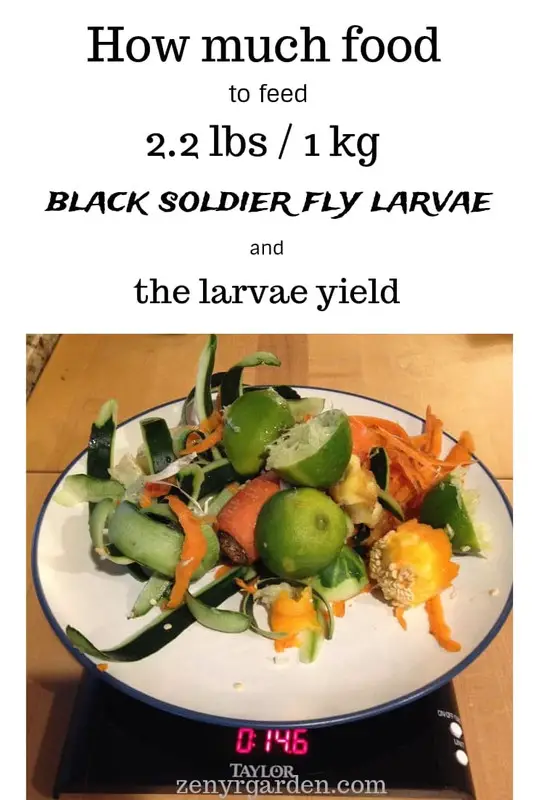To get about 1 kg of black soldier fly larvae, the food input can be around 3-5 kg daily. The amount varies depending on how many larvae are in one place, what type of food is available for the season, or more practically the cost of the food at the moment.
If you start from 50 grams of BSF eggs & growing conditions are good, you could end up with about 200 kg of larvae after 15 days of raising.
A grower asks then: how many black soldier fly larvae will make up 1kg weight?
It is a good question. It depends on when you harvest the larvae. For example, for 15-day-old larvae, about 8000 larvae will make up 1kg. For 5-day-old larvae, over 833000 larvae will equate a kilo.
Here is a small table of the gram for each larvae at different stages:
| Larvae stage | Larvae count in one kilo | Average Individual larvae weight |
|---|---|---|
| 5 days old | 833000+ larvae | 0.0012 gram |
| 10 days old | ~16000 larvae | 0.0625 gram |
| 15 days old | ~8000 larvae | 0.125 gram |
What this means, as a quick way to get 1000 15-day-old larvae for sale, you could measure out about 125 grams of them.
But enough of the weight measurements.
Going back to our topic of feeding:
In some places, the soybean waste or the left-over of tofu making, is very cheap. So growers can feed the larvae a bit more with this stuff.
As an estimation, for 1 kg of larvae, the feeding amount can be:
| Daily feed amount for 1 kg of larvae |
|---|
| 4-6 kg soybean pulp |
| 3 kg spent potatoes |
| 5 kg beer grains |
| 2 kg rice bran |
| 1.25 kg chicken broiler feed |
/okara-soybean-pulp.jpg)
The larvae themselves can consume 5-10 times their weight. This means they can eat 5-10 kg of food easily if you let them to. But this may not be something practical to do because of the food waste costs. So people adjust the ratio to about 1:1, 1:2 or some ratio that fits their needs.
The average feed cost range in different places goes from $0.03 to $0.20 per kilo. Some places utilize the food waste sources that they can get for free or very cheap.
If you grow these foods in your garden or have chickens or ducks, you can get some of the veggies & manure to feed the larvae. The end-of-season fruits or foods that are available in abundance are great sources to get started.
Some Notes on Feeding
#1. Temperature
If you use rice bran, it's good to mix in some beer grains, spent cassava or spent barley. Because rice bran alone generates quite a bit of heat. Together with the body heat of the wiggling larvae, this can make the feeding area hot & uncomfortable for them.
The very max they can go is 105-110F (40-43C). Sometimes you can even feel it when you put your hands near the feeding area. If the density is low, the larvae will find some cooler places to move out. If the density is high, then this can make the larvae grow smaller & slower.
If it gets cold at night in your local area, place some burlap or a piece of fabric over to keep the larvae warm. The lowest temp to keep them active is about 65-70F (18-21C). Below that the larvae may go into hibernation.
Covering the feed area also lowers the chances of houseflies laying eggs in the same area. The warmth helps keep your larvae growing steadily at a good size.
#2. Density
If you'd like your larvae to grow bigger, then consider spacing out the population. For example, for 1 meter square put in about 3-5 grams of egg initially. With this amount, in 2 weeks, you can end up with about 15-25 kg larvae.
The total food input is 25-45 kg depending on your food choice. The larvae tend to grow bigger in a less crowded area which doesn't cause the heat issue & they don't have to fight for food too aggressively.
#3. Pre-Treating Foods & Reducing Foul Smell
If you get food sources from some other places & don't know whether the foods contain pesticide residue, it's advisable to spray them with some beneficial microbial enzymes. It's a good idea, for example if you feed the larvae with apples, to soak the apples in clean water for some 20-30 minutes. Such will help remove some of the pesticides.
If you use microbial enzymes, some good microbes are the Lactobacillus, Bacillus, Saccharomyces. These guys help break down any potential trouble makers & keep the food almost smell-free. It will have a light sour bearable scent. With a less unpleasant smell, it's easier to handle for humans & also discourages houseflies from getting near.
They usually sell the enzyme in a bag. For 1 kg enzyme, mix in about 3-5 kg sugar (or molasses) & 100 liter of water. From this starter enzyme, we can then add 900 liters of water to make 1000 liter second-generation enzyme that can be used to chop down any left-over pesticide residue or harmful stuff. This process happens quickly within about a week. You can also try fermenting or 'cool boiling' the foods for 4-5 days to keep it safe & reduce the smell.
For fermenting food for black soldier flies, you could check out this post later:
#4. Shredding, Turning, Moisture & Air Flow
Shredding or cooking the foods is not totally needed but it does help the larvae to digest easier & faster. Some shredding machine can shred up to 400kg of waste per hour. So it's very labor-saving in some cases.
It's okay to turn the food every now & then. This helps dissipate the heat out so it doesn't get too hot in one place. Turning a bit also gives some more oxygen to the babies & helps distribute the food pieces more evenly for everyone.
A good moisture content for the foods is around 60-70%. If it gets too wet, there may be less oxygen for the larvae to breathe. It might also attract grain mites if you're using grains. To fluff the food up if it's overly moist or mucky, use some dry sawdust or coco peat to absorb some of the moisture out.
For good air flow, some people use rice husks or spent barley. This makes it easier to sift out later when you harvest your larvae.
In Summary: The Input & The Output
The food intake & larvae yield can be estimated to something like this:
| Grams of egg | Daily food | Total food 15 days | Larvae yield |
|---|---|---|---|
| 10 | 3-4kg / 6.6-8.8lbs | 50kg / 110 lbs | 20kg / 44 lbs |
| 20 | 4-6kg / 8.8-13lbs | 60-90kg / 132-198 lbs | 40kg / 88 lbs |
The key is the cost of food input, which varies depending on the season or region. Once we get that solved, the returns from the larvae for the fish, chickens, pets are quite impressive & sustainable.
If you have any comments, please leave them in the comment box. Thanks for visiting & Good luck getting started!
Share or pin this post!


